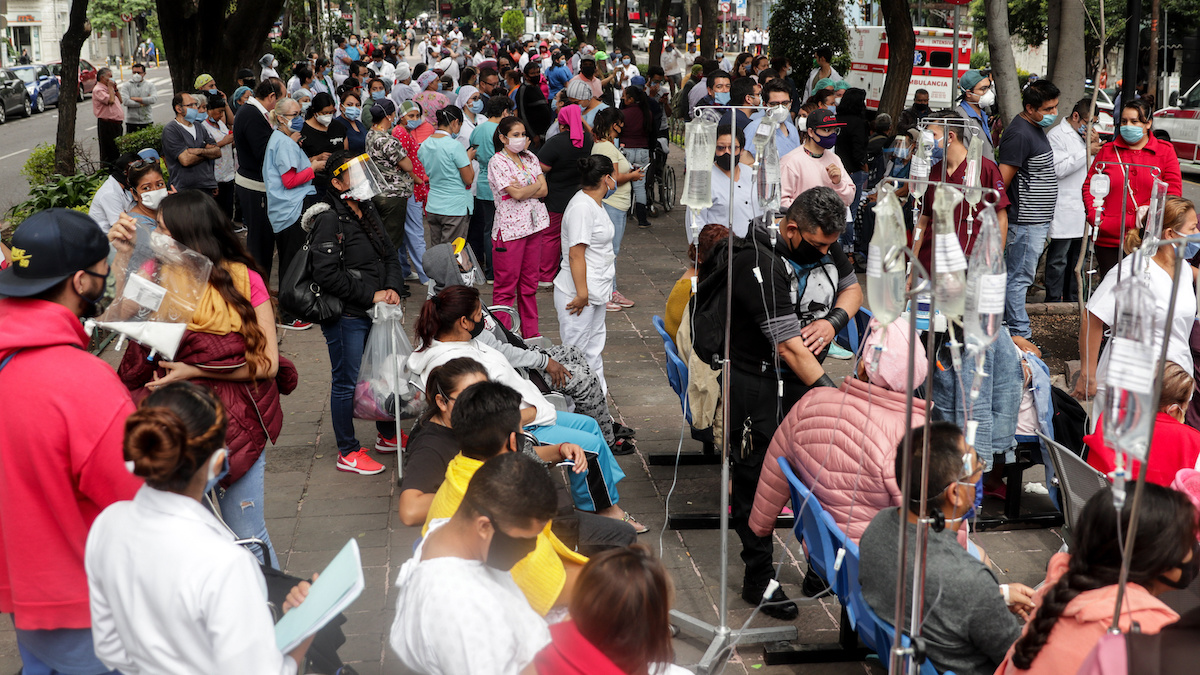

Evacuated patients, medical workers and local residents on a street in Mexico City, Mexico, after an earthquake more than 400 miles away rattled the city on June 23, 2020. Francisco Canedo / Xinhua via Getty Images
A powerful earthquake rattled Mexico Tuesday, killing at least six people, Reuters reported.
Mexico’s national seismological service said the quake had a magnitude of 7.5 while the U.S. Geological Survey (USGS) put it at 7.4, according to The New York Times. It struck around 10:29 a.m. local time and was centered about 14 miles off the Pacific Coast of the southern state of Oaxaca.
SISMO Magnitud 7.5 Loc 23 km al SUR de CRUCECITA, OAX 23/06/20 10:29:02 Lat 15.57 Lon -96.09 Pf 5 km pic.twitter.com/8uuY2um91w
— Sismologico Nacional (@SismologicoMX) June 23, 2020
Around 200 houses near the epicenter were damaged, a local official told Reuters, 30 severely so.
“We lost everything in one moment to nature,” Vicente Romero, a stationary store owner whose home was significantly damaged, told Reuters. “This is our life’s work.”
#BREAKING: A magnitude 7.4 earthquake strikes Mexico. Look at this video of a building in the area where the earthquake happened.#FOX26 #LIVEDESK
— Michael Ikahihifo (@Mike_Ikahihifo) June 23, 2020
One of the deaths occurred at state-run oil company Pemex, when a worker fell off a refinery structure, The Guardian reported. The earthquake also sparked a fire at a Pemex refinery in the Pacific city of Salina Cruz. It injured one worker before it was snuffed out.
Another person died when a building collapsed in Huatulco, Oaxaca and a third when a house collapsed in the village of San Juan Ozolotepec. A fourth man was killed when a wall collapsed on him in the village of San Agustín Amatengo.
Despite these individual tragedies, the overall damage was relatively minor.
“Fortunately there was no major damage,” Mexican President Andrés Manuel López Obrador said in a Twitter video reported by The New York Times.
Tercer mensaje al pueblo de México tras sismo. pic.twitter.com/5Kn9jPVmu3
— Andrés Manuel (@lopezobrador_) June 23, 2020
Obrador said there had been 147 aftershocks as of early Tuesday afternoon.
“I hope and I wish with all my soul that there will be no more damaging aftershocks,” he said.
Some of the buildings that were damaged included hospitals, The Oaxacan Health Services said, as CNN reported. Two of the damaged hospitals had been treating coronavirus patients.
“We are verifying [damages] because this hospital is also tending Covid cases on the Oaxacan coast,” Oaxaca state Gov. Alejandro Murat said, as CNN reported.
The earthquake was felt in Guatemala, Honduras and El Salvador and rattled buildings in Mexico City, more than 400 miles away.
LOOK: A powerful 7.4 magnitude earthquake swayed buildings in Mexico City and sent thousands fleeing into the streets pic.twitter.com/CegigYyFvT
— Bloomberg Quicktake (@Quicktake) June 24, 2020
“It really moved,” Francisco Aceves, who owns an import-export firm in Mexico City and was on the 22nd floor of an office building when it started, told The Guardian.
Two people in Mexico’s capital were injured and more than 30 buildings were damaged, Reuters reported.
Mexico is one of the most seismically active countries in the world, according to CNN, because it sits atop three tectonic plates.
Tuesday’s quake comes less than three years after a 2017 earthquake killed hundreds in Mexico City and rendered thousands homeless, BBC News pointed out.
Also in 2017, Mexico was struck by the strongest earthquake to rattle it in a century when an 8.2 temblor was recorded off the Pacific Coast, according to The New York Times. That earthquake killed at least 90 and mostly impacted the states of Oaxaca and Chiapas.
Eunice Pineda, a 26-year-old teacher in Juchitan, told Reuters that Tuesday’s quake “was two minutes of torture,” but she also had adopted a philosophical outlook about the earthquakes that rattle her home.
“We learn to appreciate, to treasure every moment,” she said.
- 5.4 Earthquake Rattles Croatian Capital, Forcing Residents out of ...
- 7.7 Earthquake in Caribbean Prompts Evacuations as Far Away as ...

 233k
233k  41k
41k  Subscribe
Subscribe 